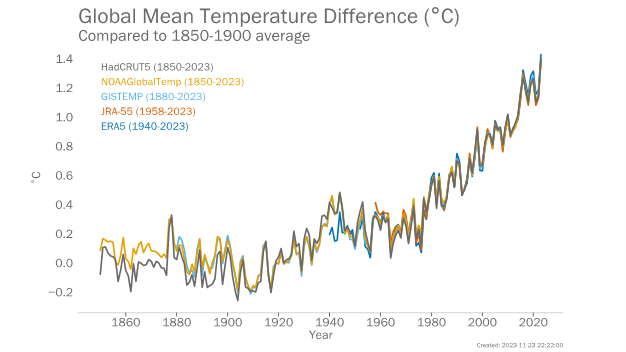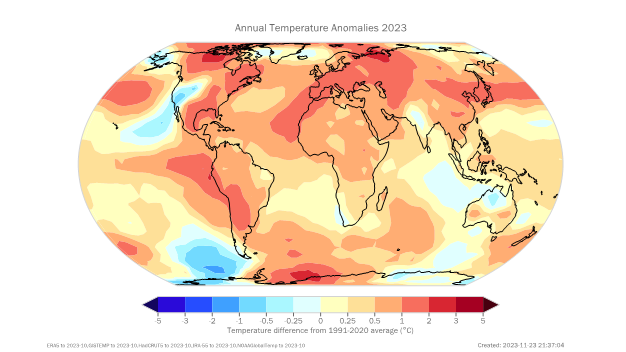The World Meteorological Organization (WMO) has declared that 2023 is set to become the warmest year on record, breaking a series of alarming climate milestones with profound implications for the planet. The WMO provisional State of the Global Climate report, released on November 30, paints a grim picture of escalating environmental challenges, from soaring temperatures to unprecedented sea level rise.
Data until the end of October indicates that 2023 exceeded the pre-industrial 1850-1900 baseline by about 1.40 degrees Celsius, with a margin of uncertainty of ±0.12°C. This puts 2023 ahead of 2016 and 2020, previously ranked as the warmest years. The report also highlights that the past nine years, from 2015 to 2023, collectively represent the warmest period on record.
WMO Secretary-General Prof. Petteri Taalas emphasised the record-breaking nature of the climate crisis, stating in a press release that “Greenhouse gas levels are record high. Global temperatures are record-high. Sea level rise is record high. Antarctic sea ice is record low. It’s a deafening cacophony of broken records.” He warned against the dire consequences, urging immediate action to mitigate the increasingly inhospitable climate.

The El Niño event, which emerged during the Northern Hemisphere spring of 2023, is anticipated to intensify the heat in 2024, further exacerbating the global temperature rise.
Carbon dioxide levels, a significant contributor to climate change, have reached 50% higher than the pre-industrial era, resulting in a continuous trapping of heat in the atmosphere. The long lifespan of CO2 ensures that temperatures will continue to rise for years to come.
The report underscores the alarming rate of sea level rise, more than twice the rate observed in the first decade of the satellite record (1993-2002). This acceleration is attributed to ongoing ocean warming and melting glaciers and ice sheets.

The Antarctic sea-ice extent for the year hit a new low, being 1 million km2 less than the previous record, equivalent to the size of France and Germany combined. Glaciers in North America and Europe experienced extreme melting, with Swiss glaciers losing approximately 10% of their remaining volume over the past two years.
The report further highlights the global socio-economic impacts of climate change, affecting food security and leading to population displacement.
In a video message, United Nations Secretary-General António Guterres called on world leaders to take immediate action at the UN Climate Change negotiations, COP28. Guterres urged leaders to commit to clear expectations for the next round of climate action plans, triple renewables, double energy efficiency, and phase out fossil fuels within a timeframe aligned with the 1.5-degree limit.
Renewable energy showed promise, with capacity growing nearly 10% in 2022, led by solar and wind power.
The final State of the Global Climate 2023 report and regional reports are expected to be published in the first half of 2024, providing a comprehensive overview of the current climate crisis. (nsh)
Banner photo: Pixabay/pexels.com















